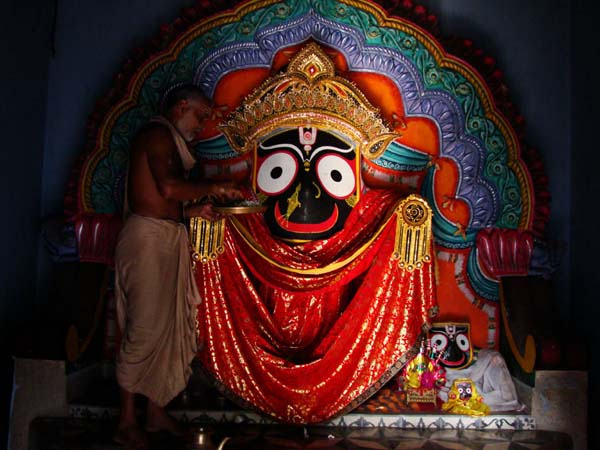Stella Polaris
| Neutiquam Erro |
I randomly came across a PDF from what turns out to be an e-magazine called Orissa Review. They have some interesting articles, poems/prayers and things about Jagannath. I honestly don't know much about him, his worship, history, etc.

He has a very different look from nearly all the other deities.
I don't know if this is all appropriate and I don't mean anything bad, but he sort of looks...cute? I'm not sure that's the feeling the "Lord of the Universe" is supposed to evoke, but he does have a smiley, welcoming appearance. At least to me.
I thought this was interesting, from an article titled "Entry of Non-Hindus to the Jagannath Temple, Puri : A Study"
From the June 2012 publication.
I don't know if that is in fact correct, but is sounds nice and appealing.
I was curious if anyone worships Jagannath?
I haven't ever come across anyone that does online.
Also, if there's anyone that's curious, here's the link to the e-magazine with monthly publications and articles (for ones about Jagannath, you have to look within each month, they're sort of scattered around).
Does anyone know of any other good resources to learn more?

He has a very different look from nearly all the other deities.
I don't know if this is all appropriate and I don't mean anything bad, but he sort of looks...cute? I'm not sure that's the feeling the "Lord of the Universe" is supposed to evoke, but he does have a smiley, welcoming appearance. At least to me.
I thought this was interesting, from an article titled "Entry of Non-Hindus to the Jagannath Temple, Puri : A Study"
From the June 2012 publication.
Since time immemorial, Odisha has been the hunting land for different religious faiths, like Brahmanism, Buddhism, Jainism, Saivism and Sakti cult. By the course of time, these religions synthesized themselves in the Cult of Jagannath. Jagannath, the presiding deity of Odisha is considered as the Lord of the Universe. He holds a unique place in the history of the land and in the lives and customs of its people. Jagannath cult is unique cult—an all embracing synthesis of cults.
Jagannath culture believes in universality and not in sectarianism. Jagannath is the God of the masses and hence Jagannath culture is a mass culture. In different ages, he has been worshipped by the primitive tribals, Aryans, Dravidians, Hindus, Jainas, Buddhists, Sikhs, Saktas, Shaivites and Vaishnavites. Apart from influencing other culture, it has incorporated into its fold the cultures of various faiths. It aims at bringing the entire human community of the world into the ambit of one family.
This cult has a unique quality of tolerance. It tolerates all religions, races, castes, customs, and cultures. It is the positive approach to other groups and communities. It stands for religious tolerance, co-existence of religions, communal harmony and international integration. Irrespective of caste, creed, colour and community, Lord Jagannath is worshipped by all. The messages of unity, equality, peaceful co-existence and fraternity are the different qualities of Jagannath cult.
I don't know if that is in fact correct, but is sounds nice and appealing.
I was curious if anyone worships Jagannath?
I haven't ever come across anyone that does online.
Also, if there's anyone that's curious, here's the link to the e-magazine with monthly publications and articles (for ones about Jagannath, you have to look within each month, they're sort of scattered around).
Does anyone know of any other good resources to learn more?
Last edited:

